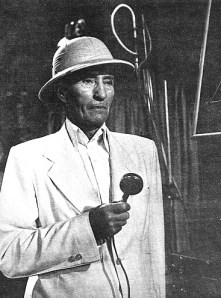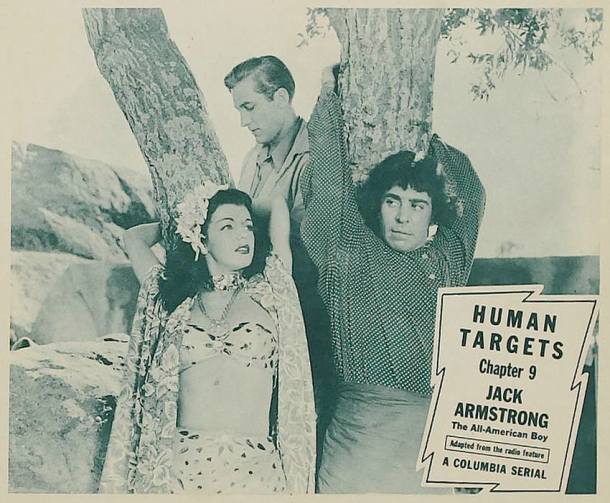 Brick Bradford is the worst of the three Columbia serials produced by “Jungle” Sam Katzman that I’ve seen so far, and that’s saying something.
Brick Bradford is the worst of the three Columbia serials produced by “Jungle” Sam Katzman that I’ve seen so far, and that’s saying something.
The previous couple of Katzman-produced serials I watched — Jack Armstrong and The Sea Hound (both made in 1947) — suffered from a similar lack of focus across their 15 weekly chapters, but Brick Bradford takes it to a new level by setting up a tantalizingly trashy science-fiction scenario and then abandoning it halfway through.
Brick Bradford was directed by Spencer Gordon Bennet and Thomas Carr and based on the daily newspaper strip created by writer William Ritt and artist Clarence Gray that began in 1933.
Brick Bradford was a square-jawed, spacefaring, time-traveling adventurer in the mold of Buck Rogers and Flash Gordon. He’s played by serial superstar Kane Richmond, who also starred in Spy Smasher (1942), one of my favorite serials, and as Lamont Cranston, a.k.a. The Shadow, in The Shadow Returns, Behind the Mask, and The Missing Lady (all 1946), as well as innumerable other B movies and chapterplays over the course of his career. When he appeared in Brick Bradford he was pushing 41, and he would only appear in one more film before retiring from acting — William Nigh’s Stage Struck (1948).
Richmond is definitely not the problem with Brick Bradford. He still looks great and can carry himself in a fistfight. The problem is that it leaves so many plot threads hanging at the end.
Chrome-domed, bespectacled scientist Dr. Gregor Tymak (John Merton) invents an “interceptor ray” that could be used to shoot down atomic weapons, but that could also be easily tinkered with and made into a terrifying weapon. Definitely not something that should fall into the wrong hands.
Tymak has also invented a “crystal door” that can be used to move through space and time, or through what Tymak calls “the fifth dimension.” He uses it to travel to the far side of the moon, which no one has ever seen before. Despite what you may have heard, the dark side of the moon is as bright as high noon in California, has a breathable atmosphere, and is the perfect place to mine “lunarium.” It also has plenty of moonhabitants, who are mostly overweight middle-aged men with capes and Centurion helmets.
Unsurprisingly, producer Katzman’s vision of life on the moon isn’t too far removed from his vision of life in the jungle, but I felt like there was some cheesy good fun to be had on the moon with the evil dictator Zuntar (Robert Barron) and his queen Khana (Carol Forman), and their war against the “exiles,” a group of scientists from the earth who were able to reach the moon and form a utopian civilization. For the first half of Brick Bradford, Brick and his sidekick Sandy (Rick Vallin) travel back and forth to the moon through the crystal door, battling the evil super spy Laydron (Charles Quigley, the hero of the 1946 Republic serial The Crimson Ghost) on terra firma and Zuntar and Khana in orbit.
In chapter 8 of the serial, however, Brick and Sandy use Tymak’s experimental “Time Top” to travel from 1948 America to 1748 Brazil and team up with pirates to find some secret plans Tymak hid in the past among some buried treasure. This diversion is mercifully brief, but when it’s over there is literally not one more mention of the moon or anything that happened on it.
There’s some fun stuff with Tymak’s “Z-ray machine,” which is worn around the neck like a tourist’s camera (Tymak explains that the Z-ray “creates the illusion of invisibility, just as the mirror reflects the illusion of form”), but aside from that the last five chapters of the serial are a boring collection of fistfights and cliffhangers in and around Tymak’s farmhouse in the California countryside. It’s standard serial stuff, and I probably wouldn’t have found it so frustrating if I hadn’t spent every minute wondering what was going on up on the moon. Imagine if a Flash Gordon serial introduced Ming the Merciless in the first several chapters and then completely forgot about him for the climax!



